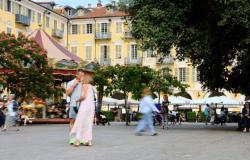■ This open access article allows you to discover the relevance and usefulness of Le Nouvel Economiste. Your registration for the free 24-hour trial will allow you to access all the articles on the site.
Who knows the port of the Champs-Élysées? The question may come as a surprise given that the avenue called “the most beautiful in the world” is especially famous for its Arc de Triomphe and its luxury brand stores. And yet. Located on the Tuileries and Concorde quays, between the Léopold-Sédar-Senghor footbridge and the Invalides bridge, it is used by pleasure boats and is in principle accessible to pedestrians. The Comité Champs-Élysées association wants to give it a leading role in winning back Parisians. And to facilitate access and use, he proposes extending the gardens of the Champs-Élysées above the traffic routes to reconnect them to the quays.
“This is an 1,800-page study. Hundreds of experts and 30 design offices participated, over 5 years, in its creation. The study is ready for use, as the feasibility of the 152 proposals has been verified.”
It is one of the 152 proposals from the study ‘Re-enchanting the Champs-Élysées’, which was officially presented on May 28 to Emmanuel Grégoire, first deputy of the mayor of Paris, during an evening organized at the Théâtre Marigny . “This is an 1,800-page study, which contains more than 400 maps,” said the president of the committee, Marc-Antoine Jamet. Several hundred experts, 30 design offices, coordinated by the PCA-Stream agency, participated, over five years, in its creation. The study is ready for use, as the feasibility of the 152 proposals it contains has been verified.”
Magical nights
This redevelopment also involves the reconquest of the gardens located at the bottom of the avenue, frequented by Marcel Proust in the last century and abandoned since the 1950s. “We must make it a place for walking again by recreating four large entrances in the form of portals; design a fun and educational route for children in partnership with the Palais de la Découverte or the Réunion des musées nationaux; install play areas; encourage sports practice; increase the number of water games…”, specifies the study, which ultimately aims for attendance comparable to that of the Tuileries, Buttes-Chaumont or the Luxembourg Gardens.
Other ways to bring people together: establish a cultural and artistic program, coordinated by a manager, for this district which has museums, theaters and cinemas; establish “magic nights” in the gardens around installations or illuminations; create major free events such as concerts, operas, parades on the Place de la Concorde; promote street arts; recreate a Christmas market, multiply the attractions.
The study also proposes widening sidewalks, increasing permeable soils by 120%, adding 5,000 m² of meadow and 5,000 m² of flowerbeds in the gardens, planting 160 new trees, doubling the surface area of shaded lawns… In total, the committee estimates the amount of its 152 proposals at 150 million euros.
It remains to be seen who will finance them. For Marc-Antoine Jamet, the work will trigger a virtuous circle: “the profound renovation of the Champs-Élysées will bring many new visitors and increase turnover. The project (…) will allow the various communities to receive new income from the taxes collected. These tax revenues are intended to finance all or part of the necessary investment”. “The city of Paris has no interest in economic taxation, with the exception of transfer taxes for valuable consideration,” recalled Emmanuel Grégoire.
A.T.







